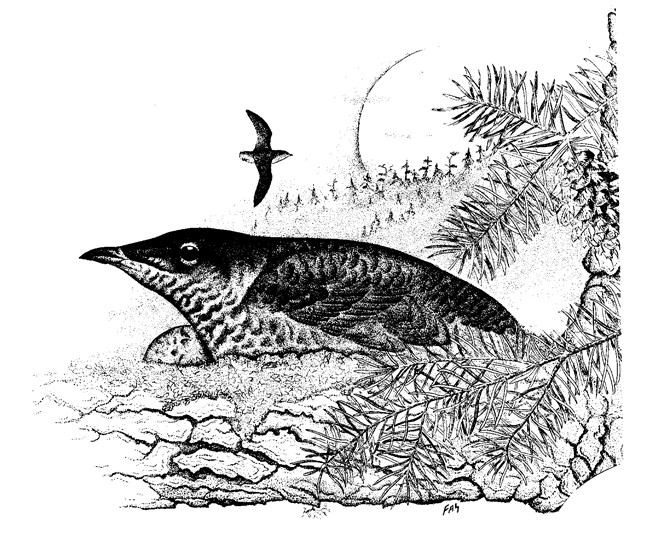
Hidden TreasuresOld growth forests hide many treasures. The best way to uncover them is an oldfashioned search. Look closely at the rocks as you cross a stream. Is that a dead leaf? A hungry banana slug? Or a tadpole of the elusive tailed frog? Adult male tailed frogs really do have small, tail-like projections. Using round, sucker-like mouths, the tadpoles attach themselves to rocks, where they feed on algae. In two years they'll turn into fully grown adult frogs.Scan other rocks. Do you see a small brown salamander with a bright yellow belly? The Olympic torrent salamander, another creature of fastmoving waters, is a special find. It is unique to the Olympic Peninsula and lives nowhere else in the world. On wet days look for the bumpy brown back and orange belly of a rough-skinned newt. They commonly cross the road. Amphibians lead double lives, part on land and part in water. Their sensitivity to changes in air and water quality may be contributing to world-wide declines in frog and salamander populations. Research indicates that Olympic National Park may be a safe haven––most of the park's 10 amphibian species seem to have healthy populations. These old growth treasures can be hard to find, but are well worth the effort! Heart O'the Hills InformationFacilities: Ranger Station/Entrance Station usually staffed when the road is open. Fees are collected year-round.Camping: 105 sites with picnic tables, fire rings with grates, restrooms, potable water, one accessible site and restroom, animalproof food storage, interpretive programs from late June to September, no RV hookups. Regulations: Pets and bicycles are not permitted on park trails. They are allowed in the campground and on park roads; pets must be on a leash (up to six feet long) at all times. Day Hikes Around Heart O' the HillsHeart O'the Forest: An easy 4.0 mile round trip. Visit pristine old growth forest. The trail starts at campground loop E.Heather Park: A steady 4.0 mile, 3,350 foot climb to wildflower meadows around Heather Park. Continue on a more difficult 2.2 miles (another 800 foot elevation gain) to Klahhane Ridge in Olympic's highcountry. Make a strenuous loop with the Lake Angeles Trail or hike to Hurricane Ridge. The trailhead is at the end of the road just north of the entrance station. Lake Angeles: Climbs 2,400 feet in 3.4 miles to Lake Angeles. Another 1,750 feet and 2.9 miles leads to Klahhane Ridge. Connect with the Heather Park Trail for a strenuous loop. Trailhead is adjacent to the Heather Park trailhead. 
Something fishy....You emerge from your tent at dawn on a summer morning. The fog is dense, the air chill, the essence of fir trees dominates your senses. In the still darkness you hear a sound and quickly dismiss it as a hallucination of your coffee-starved mind. Then you hear it again, and again. No mistaking that raucous call––a sea bird, in the old growth forest. You are among the fortunate few to hear the call of a marbled murrelet.The habits of this secretive bird, listed as threatened under the Endangered Species Act in 1992, were a mystery until very recently. Marbled murrelets are indeed sea birds. They spend the winter in the open ocean, eating small fish. But summer finds them nesting in old growth forests like the one at Heart O' the Hills. Murrelets do not build nests, but lay a single egg on a mossy branch at least 50 feet up. They still fish the ocean, so parents must fly to sea up to eight times a day to feed their chicks. These small wonders can fly faster than 65 miles per hour, useful for an animal that nests 50 miles or more from its food. Murrelets live a double life––depending on both land and sea. Oil spills and gill nets are common ocean hazards, while loss of old growth forests makes reproduction more difficult every season. Next time you rise before the sun, stand a moment under the firs. Wait and listen. Let the marbled murrelet remind you that hope haunts the treetops in the protected forests of our national parks. |
Last updated: March 19, 2018
